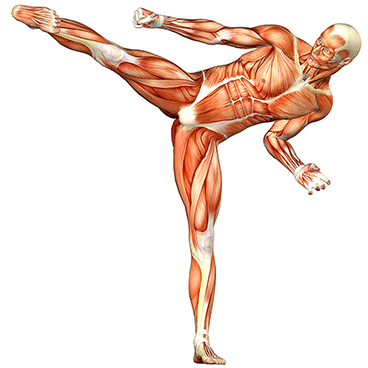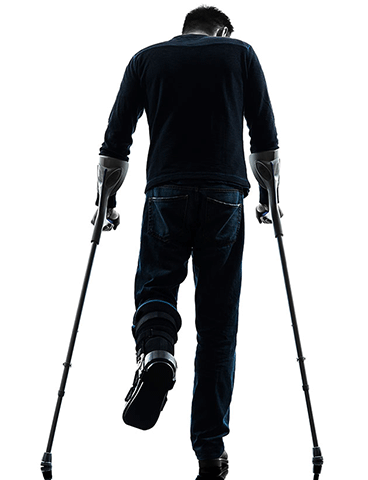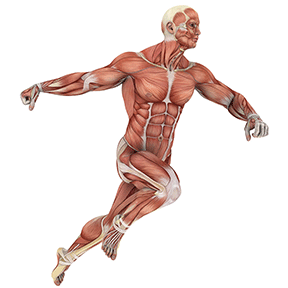
Muscles make us move, from fine control when playing piano, or massive power when lifting weights. Individual muscles are made of millions of fibers, injury to a few or all fibers result in a muscle tear. Muscles attach to bone via a tendon. Every muscle has two tendons, one at the top where it originates, and one at the bottom where it attaches. In between the tendons are the contactable muscle fibers.
All your muscles are made of the same substance. There is no need to suffer. Treatment of a muscle tear focuses on decreasing pain, inflammation and restoring the muscle length. So that the healed tissue can function as the original muscle would. Once the tear is healed our focus shifts to strength and endurance to get you back to doing what you love.
Causes of a muscle tear
- Overuse – A sudden high repetition of muscle contractions, like increasing your running distance or speed, too fast. This usually happens in January with all the New Year’s Resolutions and school athletics.
- Overload – The muscle is subjected to a sudden forceful contraction, like increasing the leg curl machine too fast.
- Overstretch – Muscles are very weak in a stretched position. When the hamstring is forcibly stretched beyond its normal boundaries, the muscle will tear. Running downhills or on an incline, will force the muscles to contract from its stretched position.
- Weakness – Muscle fatigue can lead to tears if you suddenly do an exercise that you are not used to.
- Poor management – Neglecting an injury, rest/return while you still experience symptoms, can lead to re injury.
- Inadequate warm-up – A sudden contraction, like a jump, when the muscle is not prepared for it, can put you at risk of tearing the muscle.
- Excessive stretching – of the muscle against a force, for example during a deadlift, when the load is applied on both sides of the tendon, while it needs to contract and lengthen at the same time.
- Poor technique – Ineffective movement patterns may load certain parts of the muscle more than it was designed for and lead to tears.
How bad is it?
Muscle tears are divided into three grades, depending on the amount of torn fibers.
Grade I muscle tear
A mild muscle tear where 10% of the muscle fibers are torn. This is commonly referred to as a pulled muscle.
Medical treatment
It should heal within a week without treatment. If the pain hasn’t subsided in 3 days, give us a call so we can have a look at it and determine the damage.
Symptoms
- Able to continue playing (sport), able to move.
- Pain only at the end of range (when stretched).
- No loss of muscle strength.
- Dull pain when stretched.
- Little swelling.
- No bleeding seen.
- Unable to pinpoint it to one specific spot.
Grade II muscle tear
Moderate muscle tear where 20% – 80% of the muscle fibers are torn. 20 – 80% is a big play on severity, you may have 30% fibers torn and have less symptoms that someone who had 70% fibers torn.
After swelling have disappeared (3 days) you should be able to feel a bump or dip where the most painful spot is.
Medical treatment
Contact us A.S.A.P. The faster we have a look at it before the swelling and bleeding gets too much, we can determine where the tear is and how many muscles were torn.
Symptoms
- Hear a pop or snap when it happens.
- Unable to continue play (sport), have to stop moving.
- Pain through movement.
- Loss of muscle strength.
- Sharp pain when stretched.
- Little to severe swelling.
- With or without bleeding under skin.
- Able to pinpoint it to one specific spot.
Grade III muscle tear
Severe muscle tear where 80% – 100% of the muscle fibers are torn. A completer tear (100%) is also referred to as a ruptured muscle.
Medical treatment
Contact us immediately! The faster we have a look at it before the swelling and bleeding gets too much, we can determine where the tear was and how many muscles were torn.
Symptoms
- Hearing a loud pop, snap when it happens.
- Unable to continue playing, have to stop moving.
- Sever pain through the movement.
- Able to contract the muscle, but no movement occurs.
- Severe pain when stretched.
- Always swelling.
- Always considerable amount of bleeding under skin.
- Able to pinpoint and see the muscle tear.
- Gap or bump visible.
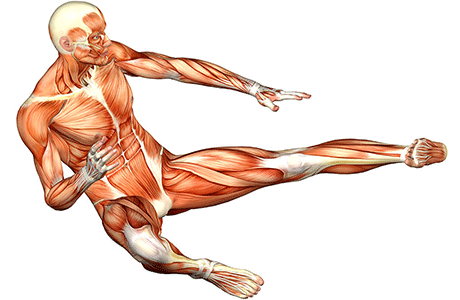
Diagnosis of a muscle tear
Our physiotherapists are experts at detecting a muscle tear because we spend 11 hours a day working on soft tissue, forgive us to say “we just have the feeling for it”. Lets be serious, the best way to confirm a muscle tear is to see it, measure the width, depth and length of the tear by using a Sonar or Ultrasound (Diagnostic Sonar).
In some cases we may refer you for an X-ray to exclude any bone pathology, but this is rare.
Any MRI will be very excessive,and is definitely not necessary to confirm a torn muscle, its way too expensive.
What you should do
Early Stage (First 48 hours)
When you have a torn muscle we recommend you follow this regiment to treat, rest and exercise the muscle.
Intermediate Stage (48 hours)
Why isn’t my muscle pain going away?
If you are asking yourself ‘why is it taking so long for the pain to go away’ then you might want to consider the following. When the muscle tears the body attempts to repair the injured fibers by sending cells to re-attach the torn ends of the fibers. It reacts similar to repairing an open wound. Like having a cut at the bottom of your foot. If you keep on walking on it, you will shear away the cells that are trying to healing and close the wound. The more you walk or run through the pain, the longer it will take to heal.
If the pain returns every time you start training or moving again, you have missed the most vital aspect of the cause of the muscle tear. The muscle length must return to its normal length before you return to participating. If you take a few days off and the pain in the calf is gone (usually 3 days) when you try training again, the pain just returns. If the muscle length is not restored, you will rip the wound wide open and start from the beginning again. This is the most common reason why patients consult us.
If you are taking anti-inflammatory medication for the a muscle tear, STOP taking them. Inflammation is the bodies natural way of healing the injured muscle fibers. The medication is preventing this process from taking place, not to mention the masking effect of the trauma on the tissue if you return to training while still taking anti-inflammatory medications.
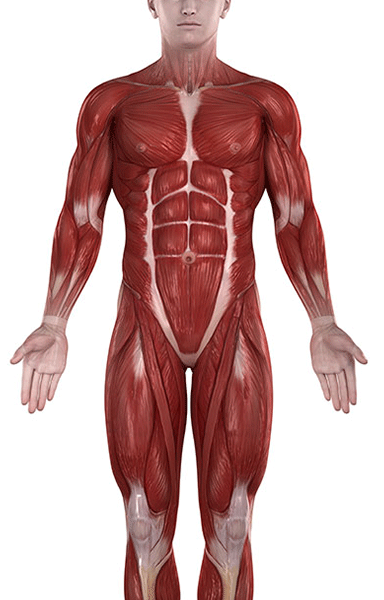
Physiological detail of how the muscle heals
Regardless of the underlying cause, the processes occurring in injured muscles tend to follow the same pattern. The rate of recovery varies from one type of injury to another and the magnitude at which your body is capable of restoring itself. You are like Wolverine — you regenerate.
The destruction phase starts with the actual trauma that causes muscle fibers to tear. Immediate necrosis of microfibers takes place due to deterioration of the sarcoplasm, a process that is halted within hours after the trauma by lysosomal vesicles forming a temporary membrane. An inflammatory process takes place as a reaction on the torn blood vessels. Specialized cells start removing dead cells and parts of the fibers that was damaged.
In the repair and remodeling phase, the actual repair of the injured muscle takes place. Microfibers start regenerating out of satellite cells (= undifferentiated reserve cells) and a connective tissue scar is being formed in the gap between the torn muscle fibers. In the first 10 days after the trauma, this scar tissue is the weakest point of the affected muscle. After 10 days however, eventual re-rupture will rather affect adjacent muscle tissue than the scar tissue itself, although full recovery (up to the point of pre-injury strength) can take a relatively long time.
Vascularisation of the injured area is a prerequisite for recovering from a muscle injury. New blood vessels grow from around the injured blood vessels and find their way to the center of the injured area. Early mobilization plays a very important role since it stimulates the blood vessel growth and supply cells to to repair the injured cells. nerves inside the muscle will regenerate to re-establish the nerve-muscle contact.
Physiotherapy treatment of muscle tears
- Acute injury treatment
- Ultrasound
- Medications
- Soft tissue massage
- Electrotherapy treatment
- Laser (Low Level Laser therapy)
- Acupuncture & Dry Needling
- Heat packs (Thermal therapy)
- Kinesiology Tape
- Rigid Strapping or taping
- Neurodynamics (Nerve tissue mobilizations)
- Dynamic Strapping
- Strengthening exercises
- Guided loading protocol
- Stretches (Static, dynamic and ballistic)
- Moon boot
Torn muscles we see daily
People involved in regular gym work damage muscles and are relatively common to get injured.
- Hamstring muscles – Hamstring muscle tear (Semimembranosus & Semitendinosus muscles)
- Quad muscles – Quadriceps muscle tear (Quadriceps muscles in the front of the thigh)
- Calf muscles – Calf muscle tear (Gastrocnemius and Soleus muscles)
- Groin muscles – Adductor muscle strain (Adductor Magnus, Adductor Longus, Adductor brevis)
- Shoulder muscle – Rotator Cuff muscle strain (Supraspinatus, Infraspinatus, Subscapularis)


